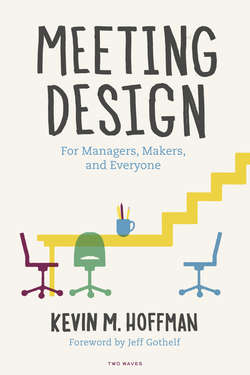Читать книгу Meeting Design - Kevin M. Hoffman - Страница 14
На сайте Литреса книга снята с продажи.
Consider Multiple Formats
ОглавлениеTeam Rocket is trying to position their design work and their client as groundbreaking in the competitive market of online meal delivery. A positive outcome of the ongoing meeting could be measured by the amount of agency (or client) blog posts around unique functionality, as it’s being developed. They are currently producing up to two blog posts per week, but that output isn’t fast enough to keep up with the conversation. Each time they meet, they talk at length about this problem, and then they talk some more.
A conversation is only one of several ways to structure this team’s time. Sadly, most meetings lean heavily on talking and only talking. Instead of talking, they could try collaboratively visualizing the process of getting a blog post published in a flow chart on the wall. A wall diagram, as seen in Figure 1.2, shows how visualizing a process in sequence can reveal efficiency gains by examining and questioning individual steps to publication. Physical objects that can be manipulated, such as sticky notes, can catalog options—pros and cons. What about even spending some time without speaking, where ideas are written and shared before being discussed?
FIGURE 1.2 Sticky notes create models to visualize discussion.
Productive meetings increase clarity about a problem, identify tactics to solve a problem, and evaluate the relative merit of those tactics. Sometimes conversation can get the job done, but constraints presented by the human brain are often inaccurate and too subjective. See Chapter 2, “The Design Constraint of All Meetings,” for an overview of these problems.
Exclusively relying on conversation and human memory is a single pattern for executing a meeting, and often a faulty pattern that creates disagreement where none may exist. There are other patterns for facilitation and capture. You’ll find them throughout the book, with most residing in Chapters 3, 4, and 5: “Build Agendas Out of Ideas, People, and Time,” “Manage Conflict with Facilitation,” and “Facilitation Strategy and Style.”
If you’ve started exploring other options, the next step is to pick the options that sound promising and start making some changes.
